Organisational Culture, Innovation, and Creativity: Nizwa Bank Report
VerifiedAdded on 2023/04/22
|11
|2242
|115
Report
AI Summary
This report analyzes the crucial role of organizational culture in fostering innovation and creativity within a banking context, using Nizwa Bank as a case study. It begins by emphasizing the importance of creativity and innovation for long-term success, followed by an exploration of the Amabile model, highlighting the significance of domain skills, creative thinking, and intrinsic motivation. The report then examines group and organizational-level support for innovation, including structure, climate, leadership, and strategy, with an emphasis on the Organizational Climate model. It also addresses the challenges banks face in promoting creativity and proposes a short-term plan involving employee involvement, resource allocation, customer engagement, and consistent evaluation. The report concludes with recommendations for enhancing organizational creativity and innovation through collaborative efforts across different departments, providing valuable insights for fostering a more innovative and creative workplace environment.
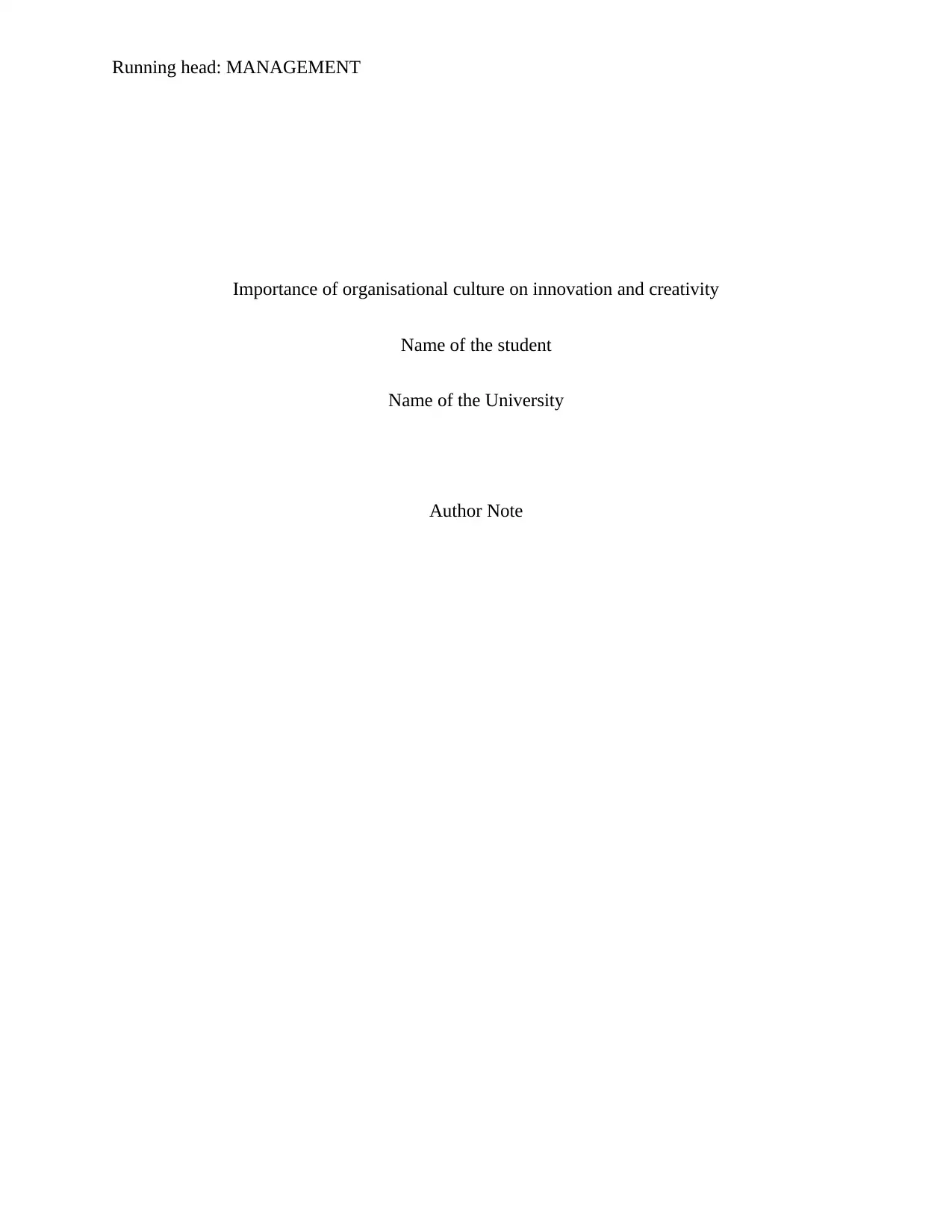
Running head: MANAGEMENT
Importance of organisational culture on innovation and creativity
Name of the student
Name of the University
Author Note
Importance of organisational culture on innovation and creativity
Name of the student
Name of the University
Author Note
Paraphrase This Document
Need a fresh take? Get an instant paraphrase of this document with our AI Paraphraser
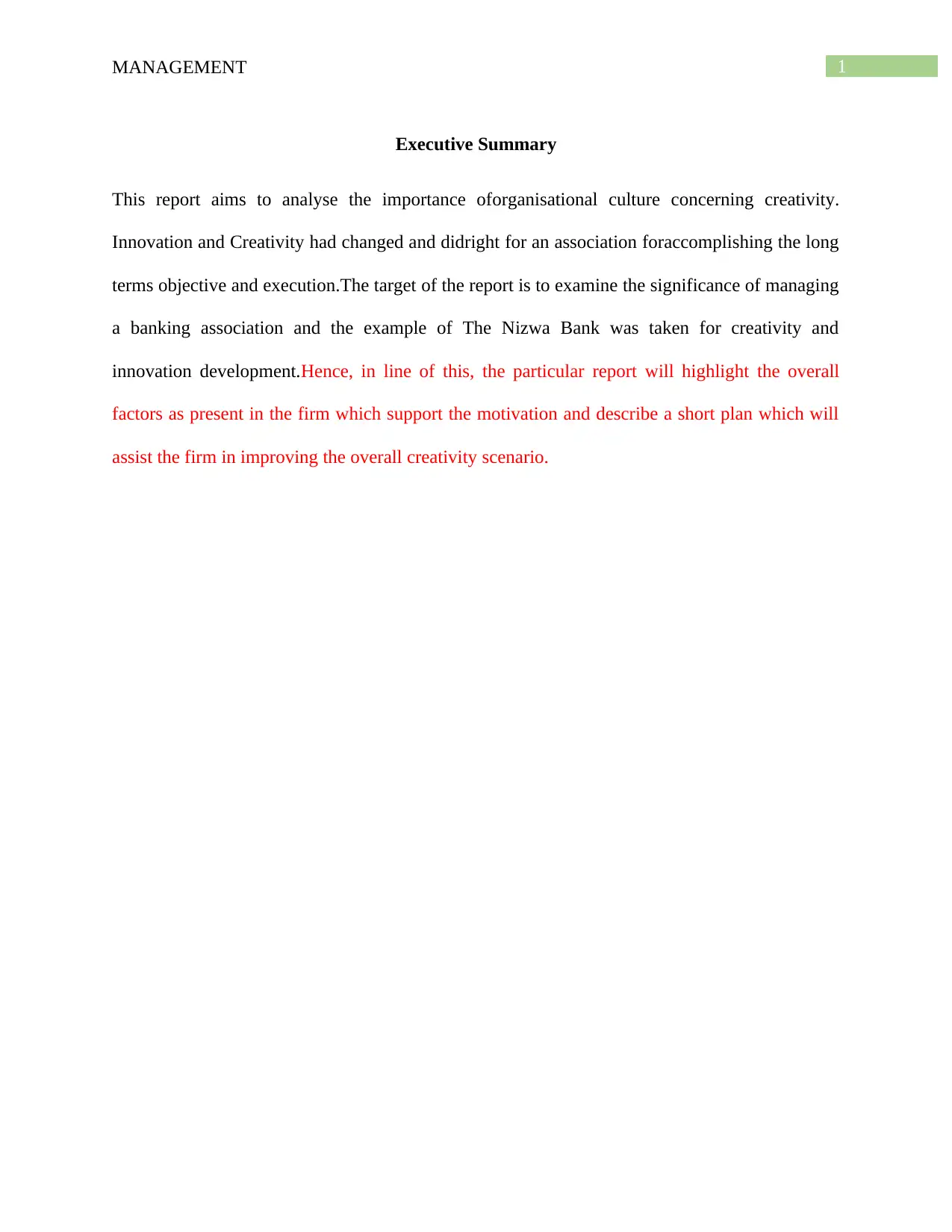
1MANAGEMENT
Executive Summary
This report aims to analyse the importance oforganisational culture concerning creativity.
Innovation and Creativity had changed and didright for an association foraccomplishing the long
terms objective and execution.The target of the report is to examine the significance of managing
a banking association and the example of The Nizwa Bank was taken for creativity and
innovation development.Hence, in line of this, the particular report will highlight the overall
factors as present in the firm which support the motivation and describe a short plan which will
assist the firm in improving the overall creativity scenario.
Executive Summary
This report aims to analyse the importance oforganisational culture concerning creativity.
Innovation and Creativity had changed and didright for an association foraccomplishing the long
terms objective and execution.The target of the report is to examine the significance of managing
a banking association and the example of The Nizwa Bank was taken for creativity and
innovation development.Hence, in line of this, the particular report will highlight the overall
factors as present in the firm which support the motivation and describe a short plan which will
assist the firm in improving the overall creativity scenario.
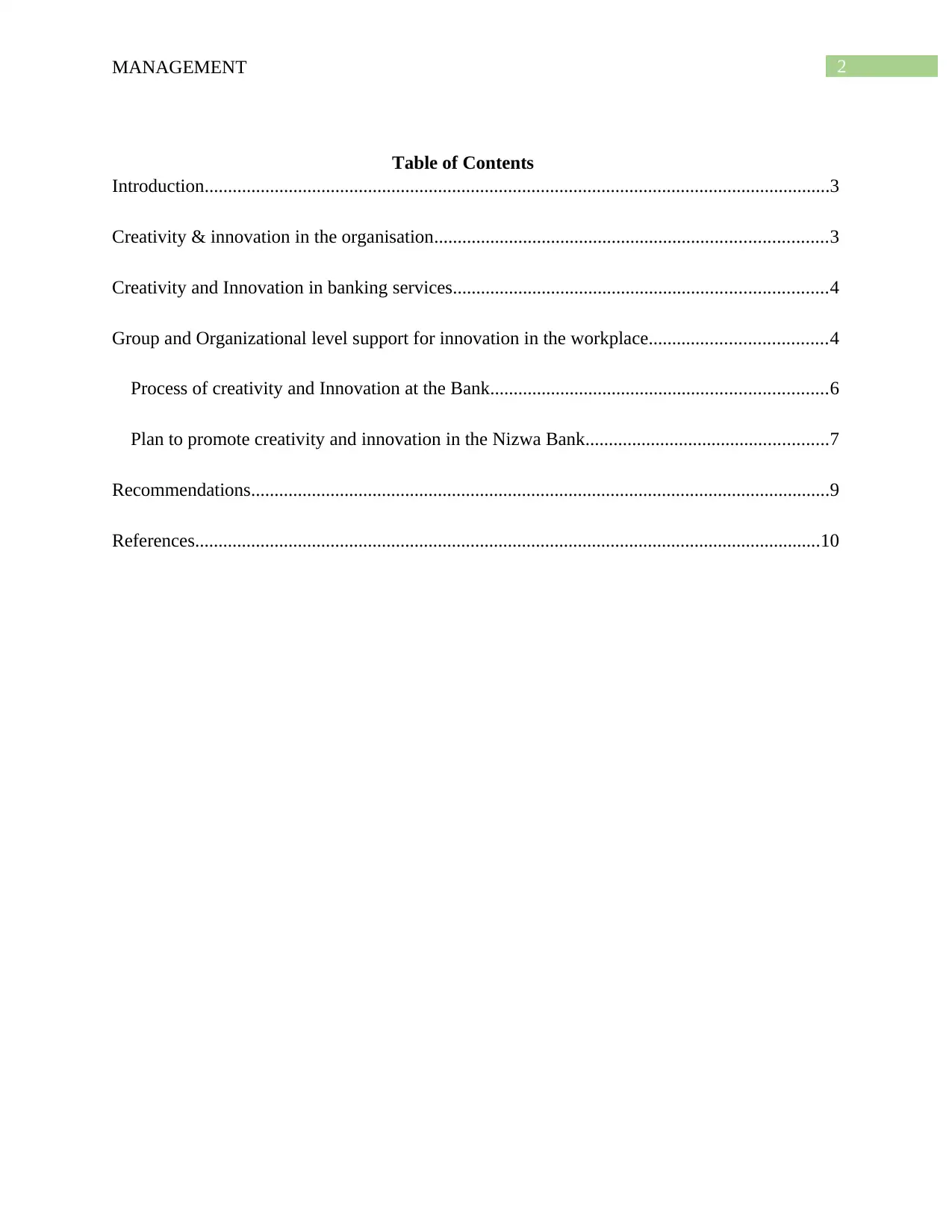
2MANAGEMENT
Table of Contents
Introduction......................................................................................................................................3
Creativity & innovation in the organisation....................................................................................3
Creativity and Innovation in banking services................................................................................4
Group and Organizational level support for innovation in the workplace......................................4
Process of creativity and Innovation at the Bank........................................................................6
Plan to promote creativity and innovation in the Nizwa Bank....................................................7
Recommendations............................................................................................................................9
References......................................................................................................................................10
Table of Contents
Introduction......................................................................................................................................3
Creativity & innovation in the organisation....................................................................................3
Creativity and Innovation in banking services................................................................................4
Group and Organizational level support for innovation in the workplace......................................4
Process of creativity and Innovation at the Bank........................................................................6
Plan to promote creativity and innovation in the Nizwa Bank....................................................7
Recommendations............................................................................................................................9
References......................................................................................................................................10
⊘ This is a preview!⊘
Do you want full access?
Subscribe today to unlock all pages.

Trusted by 1+ million students worldwide
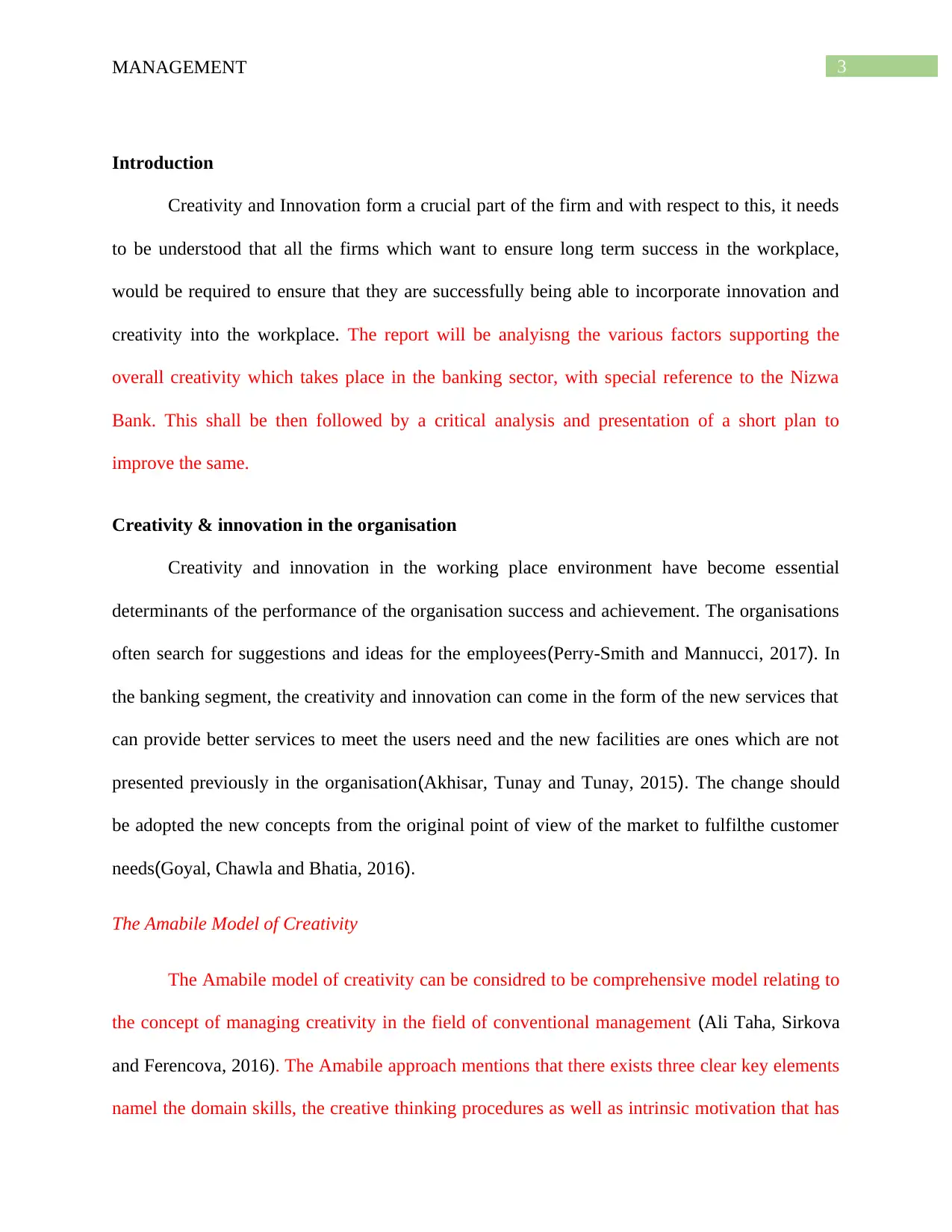
3MANAGEMENT
Introduction
Creativity and Innovation form a crucial part of the firm and with respect to this, it needs
to be understood that all the firms which want to ensure long term success in the workplace,
would be required to ensure that they are successfully being able to incorporate innovation and
creativity into the workplace. The report will be analyisng the various factors supporting the
overall creativity which takes place in the banking sector, with special reference to the Nizwa
Bank. This shall be then followed by a critical analysis and presentation of a short plan to
improve the same.
Creativity & innovation in the organisation
Creativity and innovation in the working place environment have become essential
determinants of the performance of the organisation success and achievement. The organisations
often search for suggestions and ideas for the employees(Perry-Smith and Mannucci, 2017). In
the banking segment, the creativity and innovation can come in the form of the new services that
can provide better services to meet the users need and the new facilities are ones which are not
presented previously in the organisation(Akhisar, Tunay and Tunay, 2015). The change should
be adopted the new concepts from the original point of view of the market to fulfilthe customer
needs(Goyal, Chawla and Bhatia, 2016).
The Amabile Model of Creativity
The Amabile model of creativity can be considred to be comprehensive model relating to
the concept of managing creativity in the field of conventional management (Ali Taha, Sirkova
and Ferencova, 2016). The Amabile approach mentions that there exists three clear key elements
namel the domain skills, the creative thinking procedures as well as intrinsic motivation that has
Introduction
Creativity and Innovation form a crucial part of the firm and with respect to this, it needs
to be understood that all the firms which want to ensure long term success in the workplace,
would be required to ensure that they are successfully being able to incorporate innovation and
creativity into the workplace. The report will be analyisng the various factors supporting the
overall creativity which takes place in the banking sector, with special reference to the Nizwa
Bank. This shall be then followed by a critical analysis and presentation of a short plan to
improve the same.
Creativity & innovation in the organisation
Creativity and innovation in the working place environment have become essential
determinants of the performance of the organisation success and achievement. The organisations
often search for suggestions and ideas for the employees(Perry-Smith and Mannucci, 2017). In
the banking segment, the creativity and innovation can come in the form of the new services that
can provide better services to meet the users need and the new facilities are ones which are not
presented previously in the organisation(Akhisar, Tunay and Tunay, 2015). The change should
be adopted the new concepts from the original point of view of the market to fulfilthe customer
needs(Goyal, Chawla and Bhatia, 2016).
The Amabile Model of Creativity
The Amabile model of creativity can be considred to be comprehensive model relating to
the concept of managing creativity in the field of conventional management (Ali Taha, Sirkova
and Ferencova, 2016). The Amabile approach mentions that there exists three clear key elements
namel the domain skills, the creative thinking procedures as well as intrinsic motivation that has
Paraphrase This Document
Need a fresh take? Get an instant paraphrase of this document with our AI Paraphraser
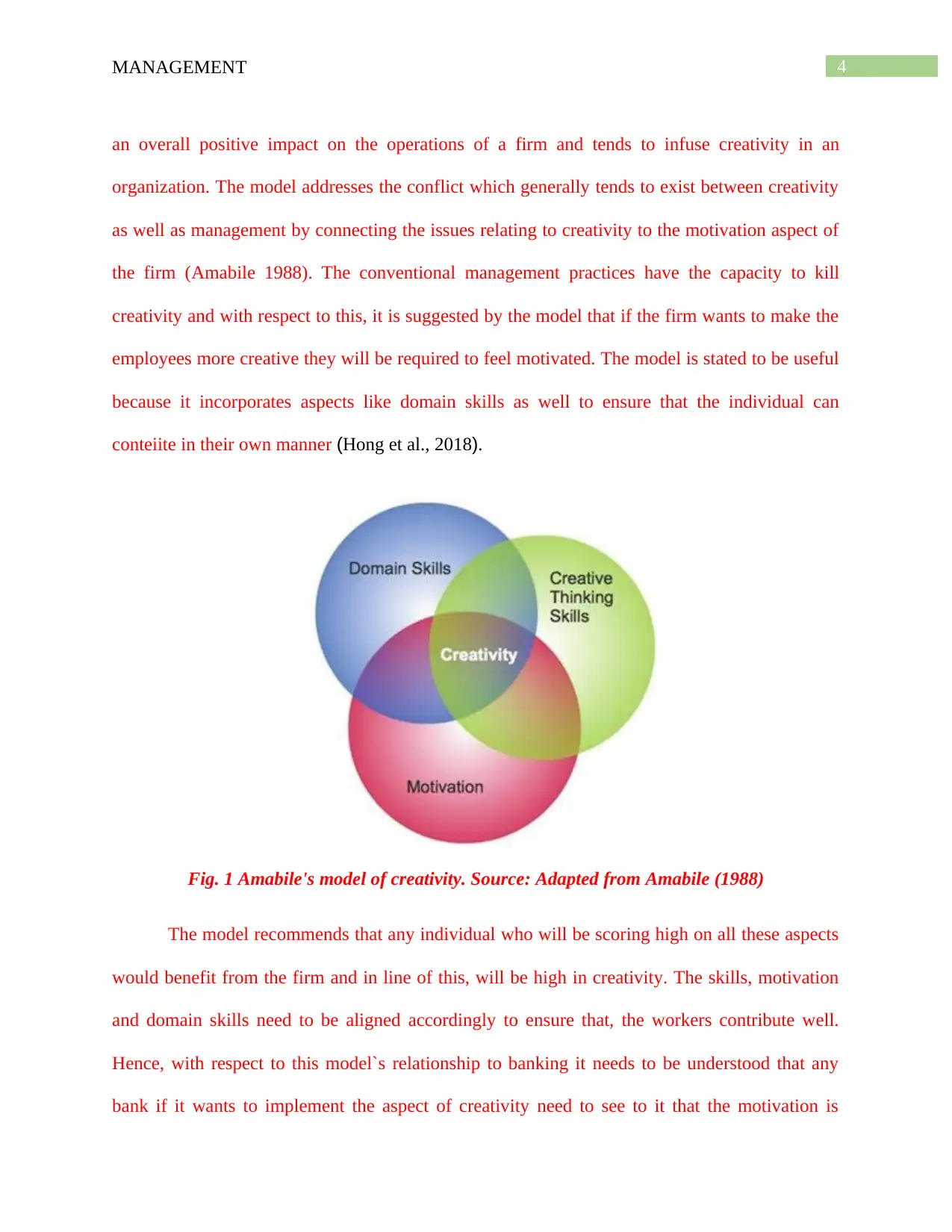
4MANAGEMENT
an overall positive impact on the operations of a firm and tends to infuse creativity in an
organization. The model addresses the conflict which generally tends to exist between creativity
as well as management by connecting the issues relating to creativity to the motivation aspect of
the firm (Amabile 1988). The conventional management practices have the capacity to kill
creativity and with respect to this, it is suggested by the model that if the firm wants to make the
employees more creative they will be required to feel motivated. The model is stated to be useful
because it incorporates aspects like domain skills as well to ensure that the individual can
conteiite in their own manner (Hong et al., 2018).
Fig. 1 Amabile's model of creativity. Source: Adapted from Amabile (1988)
The model recommends that any individual who will be scoring high on all these aspects
would benefit from the firm and in line of this, will be high in creativity. The skills, motivation
and domain skills need to be aligned accordingly to ensure that, the workers contribute well.
Hence, with respect to this model`s relationship to banking it needs to be understood that any
bank if it wants to implement the aspect of creativity need to see to it that the motivation is
an overall positive impact on the operations of a firm and tends to infuse creativity in an
organization. The model addresses the conflict which generally tends to exist between creativity
as well as management by connecting the issues relating to creativity to the motivation aspect of
the firm (Amabile 1988). The conventional management practices have the capacity to kill
creativity and with respect to this, it is suggested by the model that if the firm wants to make the
employees more creative they will be required to feel motivated. The model is stated to be useful
because it incorporates aspects like domain skills as well to ensure that the individual can
conteiite in their own manner (Hong et al., 2018).
Fig. 1 Amabile's model of creativity. Source: Adapted from Amabile (1988)
The model recommends that any individual who will be scoring high on all these aspects
would benefit from the firm and in line of this, will be high in creativity. The skills, motivation
and domain skills need to be aligned accordingly to ensure that, the workers contribute well.
Hence, with respect to this model`s relationship to banking it needs to be understood that any
bank if it wants to implement the aspect of creativity need to see to it that the motivation is
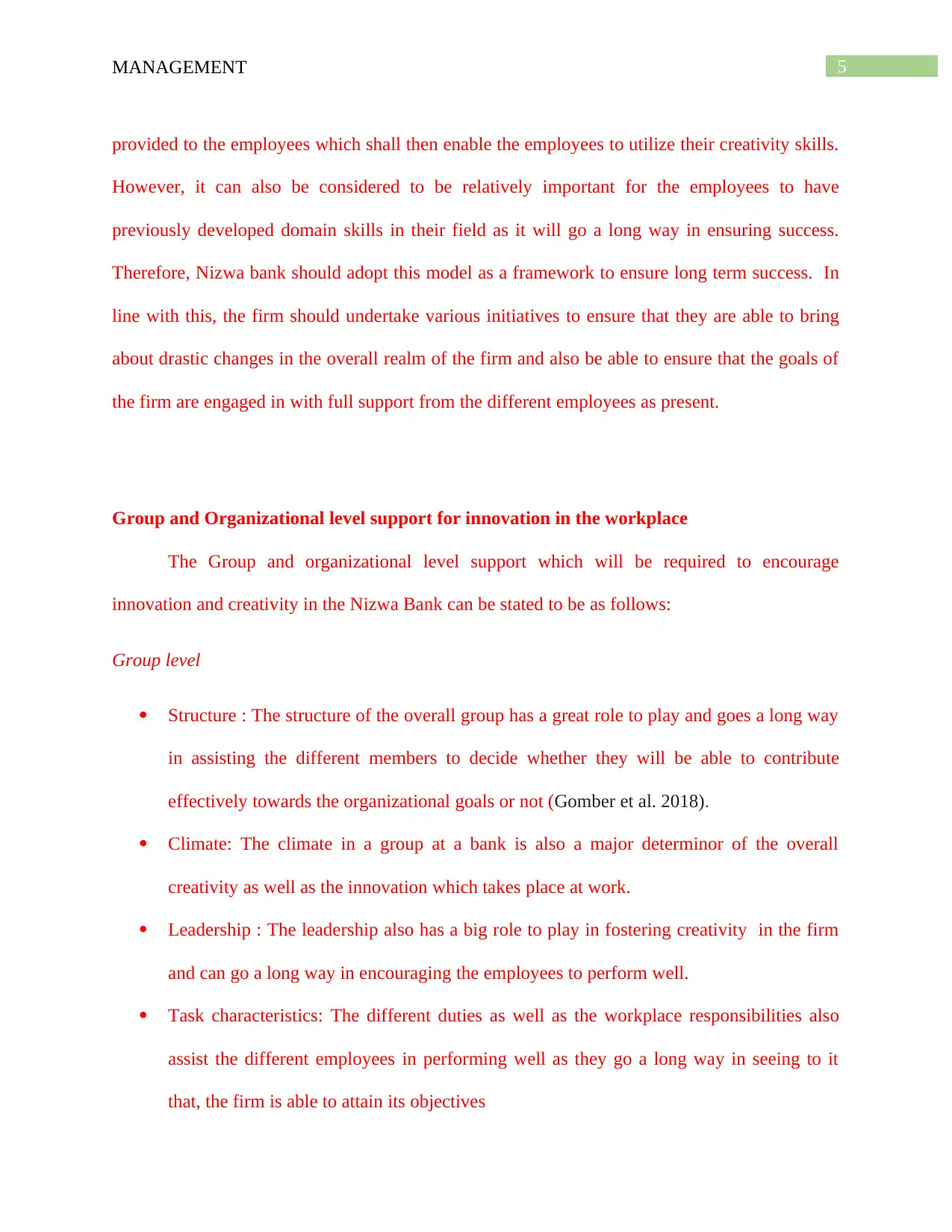
5MANAGEMENT
provided to the employees which shall then enable the employees to utilize their creativity skills.
However, it can also be considered to be relatively important for the employees to have
previously developed domain skills in their field as it will go a long way in ensuring success.
Therefore, Nizwa bank should adopt this model as a framework to ensure long term success. In
line with this, the firm should undertake various initiatives to ensure that they are able to bring
about drastic changes in the overall realm of the firm and also be able to ensure that the goals of
the firm are engaged in with full support from the different employees as present.
Group and Organizational level support for innovation in the workplace
The Group and organizational level support which will be required to encourage
innovation and creativity in the Nizwa Bank can be stated to be as follows:
Group level
Structure : The structure of the overall group has a great role to play and goes a long way
in assisting the different members to decide whether they will be able to contribute
effectively towards the organizational goals or not (Gomber et al. 2018).
Climate: The climate in a group at a bank is also a major determinor of the overall
creativity as well as the innovation which takes place at work.
Leadership : The leadership also has a big role to play in fostering creativity in the firm
and can go a long way in encouraging the employees to perform well.
Task characteristics: The different duties as well as the workplace responsibilities also
assist the different employees in performing well as they go a long way in seeing to it
that, the firm is able to attain its objectives
provided to the employees which shall then enable the employees to utilize their creativity skills.
However, it can also be considered to be relatively important for the employees to have
previously developed domain skills in their field as it will go a long way in ensuring success.
Therefore, Nizwa bank should adopt this model as a framework to ensure long term success. In
line with this, the firm should undertake various initiatives to ensure that they are able to bring
about drastic changes in the overall realm of the firm and also be able to ensure that the goals of
the firm are engaged in with full support from the different employees as present.
Group and Organizational level support for innovation in the workplace
The Group and organizational level support which will be required to encourage
innovation and creativity in the Nizwa Bank can be stated to be as follows:
Group level
Structure : The structure of the overall group has a great role to play and goes a long way
in assisting the different members to decide whether they will be able to contribute
effectively towards the organizational goals or not (Gomber et al. 2018).
Climate: The climate in a group at a bank is also a major determinor of the overall
creativity as well as the innovation which takes place at work.
Leadership : The leadership also has a big role to play in fostering creativity in the firm
and can go a long way in encouraging the employees to perform well.
Task characteristics: The different duties as well as the workplace responsibilities also
assist the different employees in performing well as they go a long way in seeing to it
that, the firm is able to attain its objectives
⊘ This is a preview!⊘
Do you want full access?
Subscribe today to unlock all pages.

Trusted by 1+ million students worldwide
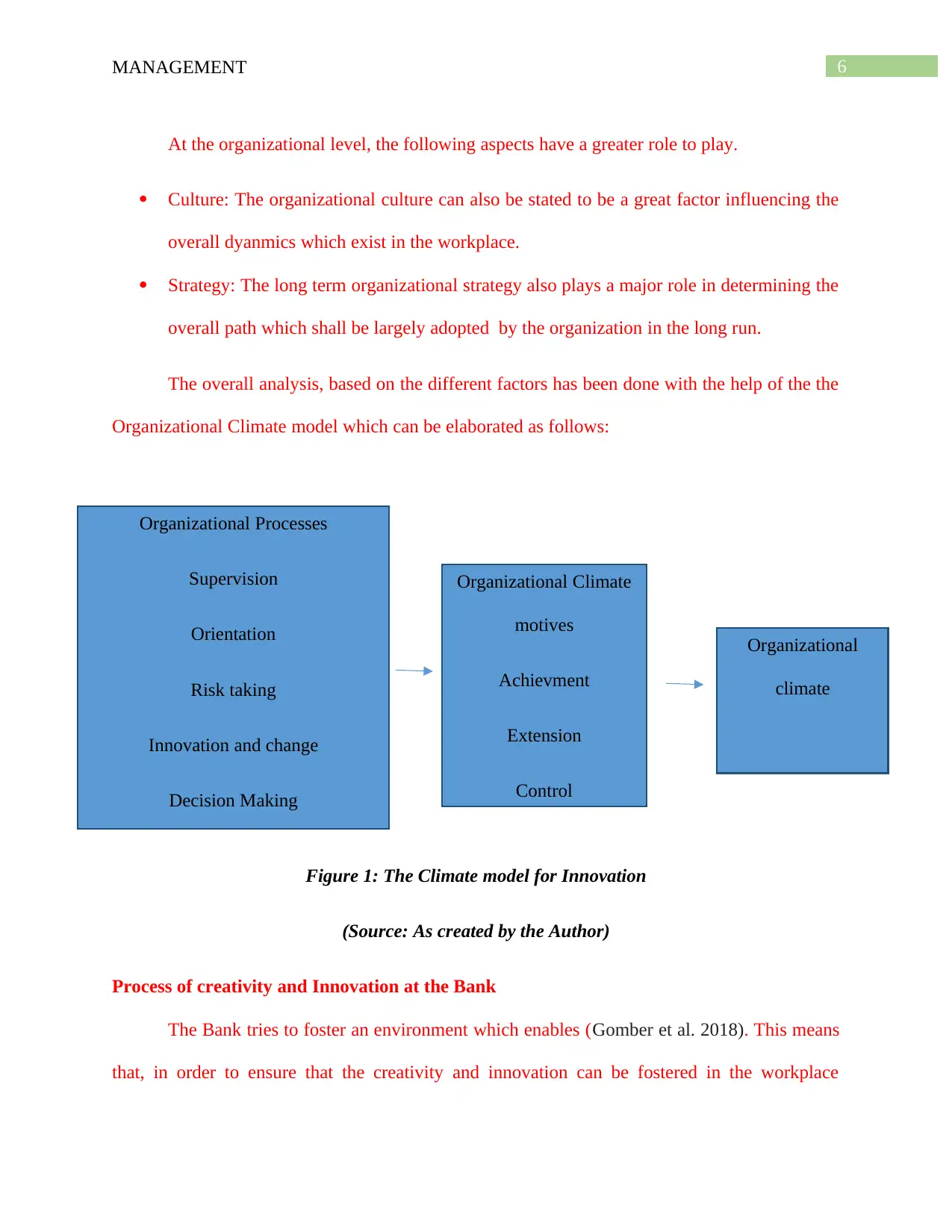
6MANAGEMENT
At the organizational level, the following aspects have a greater role to play.
Culture: The organizational culture can also be stated to be a great factor influencing the
overall dyanmics which exist in the workplace.
Strategy: The long term organizational strategy also plays a major role in determining the
overall path which shall be largely adopted by the organization in the long run.
The overall analysis, based on the different factors has been done with the help of the the
Organizational Climate model which can be elaborated as follows:
Figure 1: The Climate model for Innovation
(Source: As created by the Author)
Process of creativity and Innovation at the Bank
The Bank tries to foster an environment which enables (Gomber et al. 2018). This means
that, in order to ensure that the creativity and innovation can be fostered in the workplace
Organizational Processes
Supervision
Orientation
Risk taking
Innovation and change
Decision Making
Organizational Climate
motives
Achievment
Extension
Control
Organizational
climate
At the organizational level, the following aspects have a greater role to play.
Culture: The organizational culture can also be stated to be a great factor influencing the
overall dyanmics which exist in the workplace.
Strategy: The long term organizational strategy also plays a major role in determining the
overall path which shall be largely adopted by the organization in the long run.
The overall analysis, based on the different factors has been done with the help of the the
Organizational Climate model which can be elaborated as follows:
Figure 1: The Climate model for Innovation
(Source: As created by the Author)
Process of creativity and Innovation at the Bank
The Bank tries to foster an environment which enables (Gomber et al. 2018). This means
that, in order to ensure that the creativity and innovation can be fostered in the workplace
Organizational Processes
Supervision
Orientation
Risk taking
Innovation and change
Decision Making
Organizational Climate
motives
Achievment
Extension
Control
Organizational
climate
Paraphrase This Document
Need a fresh take? Get an instant paraphrase of this document with our AI Paraphraser
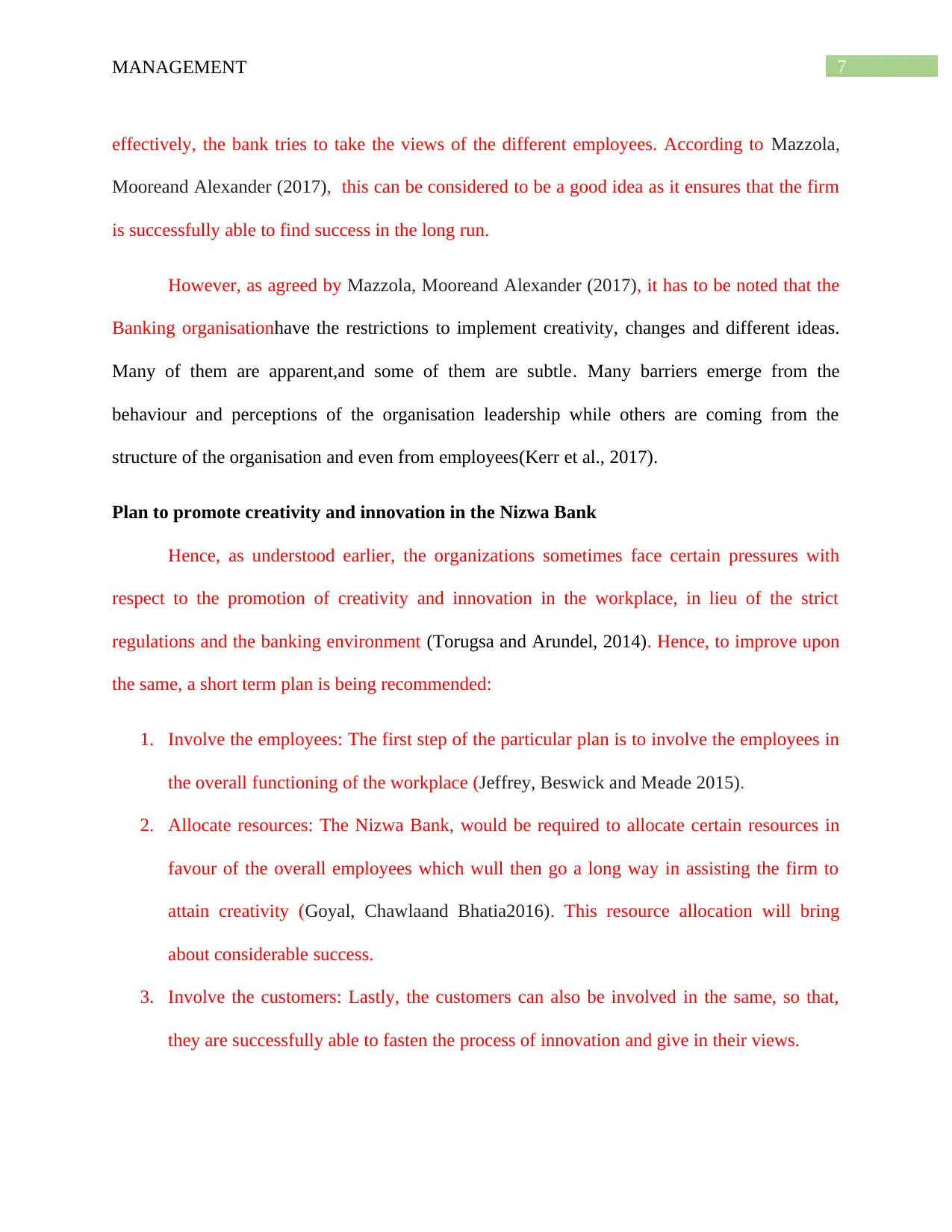
7MANAGEMENT
effectively, the bank tries to take the views of the different employees. According to Mazzola,
Mooreand Alexander (2017), this can be considered to be a good idea as it ensures that the firm
is successfully able to find success in the long run.
However, as agreed by Mazzola, Mooreand Alexander (2017), it has to be noted that the
Banking organisationhave the restrictions to implement creativity, changes and different ideas.
Many of them are apparent,and some of them are subtle. Many barriers emerge from the
behaviour and perceptions of the organisation leadership while others are coming from the
structure of the organisation and even from employees(Kerr et al., 2017).
Plan to promote creativity and innovation in the Nizwa Bank
Hence, as understood earlier, the organizations sometimes face certain pressures with
respect to the promotion of creativity and innovation in the workplace, in lieu of the strict
regulations and the banking environment (Torugsa and Arundel, 2014). Hence, to improve upon
the same, a short term plan is being recommended:
1. Involve the employees: The first step of the particular plan is to involve the employees in
the overall functioning of the workplace (Jeffrey, Beswick and Meade 2015).
2. Allocate resources: The Nizwa Bank, would be required to allocate certain resources in
favour of the overall employees which wull then go a long way in assisting the firm to
attain creativity (Goyal, Chawlaand Bhatia2016). This resource allocation will bring
about considerable success.
3. Involve the customers: Lastly, the customers can also be involved in the same, so that,
they are successfully able to fasten the process of innovation and give in their views.
effectively, the bank tries to take the views of the different employees. According to Mazzola,
Mooreand Alexander (2017), this can be considered to be a good idea as it ensures that the firm
is successfully able to find success in the long run.
However, as agreed by Mazzola, Mooreand Alexander (2017), it has to be noted that the
Banking organisationhave the restrictions to implement creativity, changes and different ideas.
Many of them are apparent,and some of them are subtle. Many barriers emerge from the
behaviour and perceptions of the organisation leadership while others are coming from the
structure of the organisation and even from employees(Kerr et al., 2017).
Plan to promote creativity and innovation in the Nizwa Bank
Hence, as understood earlier, the organizations sometimes face certain pressures with
respect to the promotion of creativity and innovation in the workplace, in lieu of the strict
regulations and the banking environment (Torugsa and Arundel, 2014). Hence, to improve upon
the same, a short term plan is being recommended:
1. Involve the employees: The first step of the particular plan is to involve the employees in
the overall functioning of the workplace (Jeffrey, Beswick and Meade 2015).
2. Allocate resources: The Nizwa Bank, would be required to allocate certain resources in
favour of the overall employees which wull then go a long way in assisting the firm to
attain creativity (Goyal, Chawlaand Bhatia2016). This resource allocation will bring
about considerable success.
3. Involve the customers: Lastly, the customers can also be involved in the same, so that,
they are successfully able to fasten the process of innovation and give in their views.
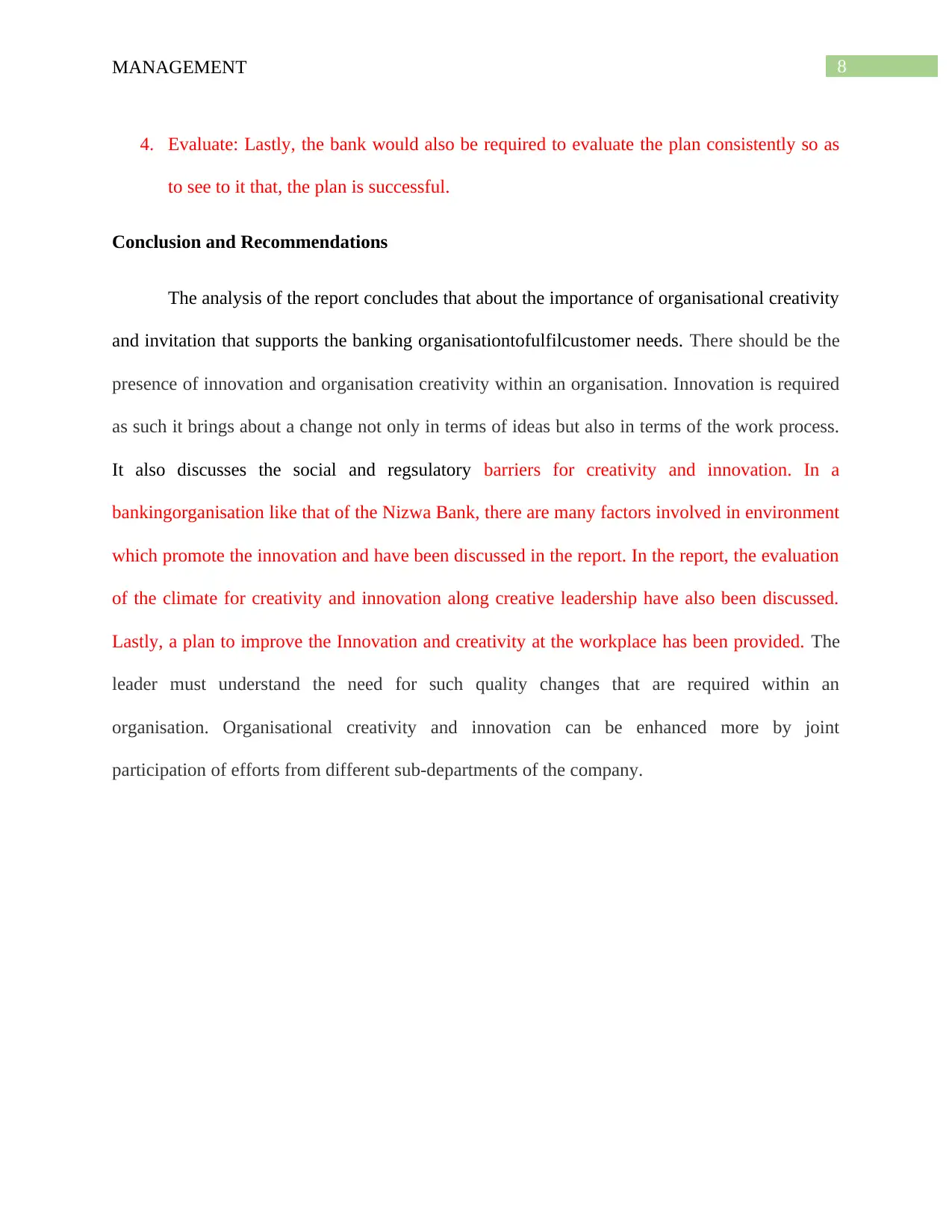
8MANAGEMENT
4. Evaluate: Lastly, the bank would also be required to evaluate the plan consistently so as
to see to it that, the plan is successful.
Conclusion and Recommendations
The analysis of the report concludes that about the importance of organisational creativity
and invitation that supports the banking organisationtofulfilcustomer needs. There should be the
presence of innovation and organisation creativity within an organisation. Innovation is required
as such it brings about a change not only in terms of ideas but also in terms of the work process.
It also discusses the social and regsulatory barriers for creativity and innovation. In a
bankingorganisation like that of the Nizwa Bank, there are many factors involved in environment
which promote the innovation and have been discussed in the report. In the report, the evaluation
of the climate for creativity and innovation along creative leadership have also been discussed.
Lastly, a plan to improve the Innovation and creativity at the workplace has been provided. The
leader must understand the need for such quality changes that are required within an
organisation. Organisational creativity and innovation can be enhanced more by joint
participation of efforts from different sub-departments of the company.
4. Evaluate: Lastly, the bank would also be required to evaluate the plan consistently so as
to see to it that, the plan is successful.
Conclusion and Recommendations
The analysis of the report concludes that about the importance of organisational creativity
and invitation that supports the banking organisationtofulfilcustomer needs. There should be the
presence of innovation and organisation creativity within an organisation. Innovation is required
as such it brings about a change not only in terms of ideas but also in terms of the work process.
It also discusses the social and regsulatory barriers for creativity and innovation. In a
bankingorganisation like that of the Nizwa Bank, there are many factors involved in environment
which promote the innovation and have been discussed in the report. In the report, the evaluation
of the climate for creativity and innovation along creative leadership have also been discussed.
Lastly, a plan to improve the Innovation and creativity at the workplace has been provided. The
leader must understand the need for such quality changes that are required within an
organisation. Organisational creativity and innovation can be enhanced more by joint
participation of efforts from different sub-departments of the company.
⊘ This is a preview!⊘
Do you want full access?
Subscribe today to unlock all pages.

Trusted by 1+ million students worldwide
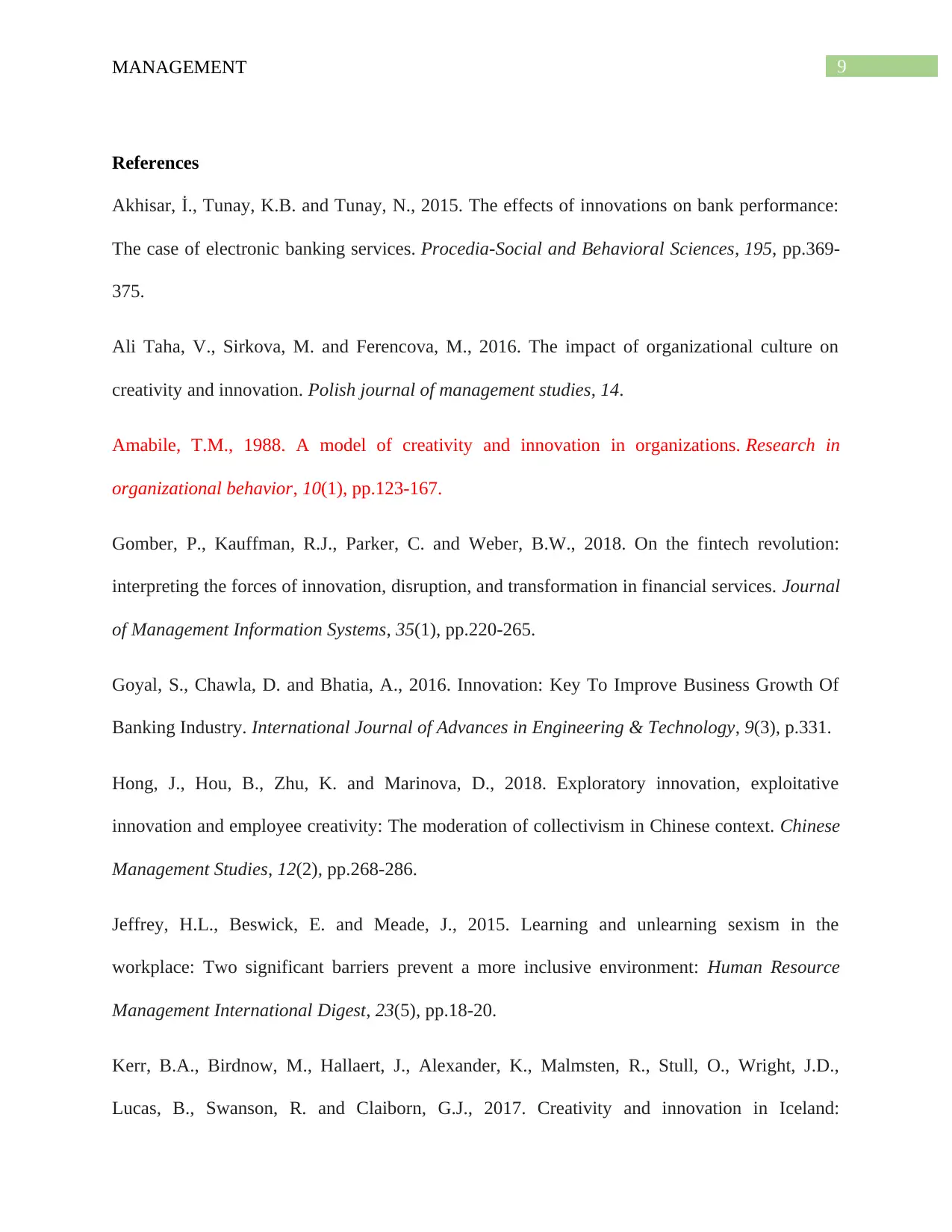
9MANAGEMENT
References
Akhisar, İ., Tunay, K.B. and Tunay, N., 2015. The effects of innovations on bank performance:
The case of electronic banking services. Procedia-Social and Behavioral Sciences, 195, pp.369-
375.
Ali Taha, V., Sirkova, M. and Ferencova, M., 2016. The impact of organizational culture on
creativity and innovation. Polish journal of management studies, 14.
Amabile, T.M., 1988. A model of creativity and innovation in organizations. Research in
organizational behavior, 10(1), pp.123-167.
Gomber, P., Kauffman, R.J., Parker, C. and Weber, B.W., 2018. On the fintech revolution:
interpreting the forces of innovation, disruption, and transformation in financial services. Journal
of Management Information Systems, 35(1), pp.220-265.
Goyal, S., Chawla, D. and Bhatia, A., 2016. Innovation: Key To Improve Business Growth Of
Banking Industry. International Journal of Advances in Engineering & Technology, 9(3), p.331.
Hong, J., Hou, B., Zhu, K. and Marinova, D., 2018. Exploratory innovation, exploitative
innovation and employee creativity: The moderation of collectivism in Chinese context. Chinese
Management Studies, 12(2), pp.268-286.
Jeffrey, H.L., Beswick, E. and Meade, J., 2015. Learning and unlearning sexism in the
workplace: Two significant barriers prevent a more inclusive environment: Human Resource
Management International Digest, 23(5), pp.18-20.
Kerr, B.A., Birdnow, M., Hallaert, J., Alexander, K., Malmsten, R., Stull, O., Wright, J.D.,
Lucas, B., Swanson, R. and Claiborn, G.J., 2017. Creativity and innovation in Iceland:
References
Akhisar, İ., Tunay, K.B. and Tunay, N., 2015. The effects of innovations on bank performance:
The case of electronic banking services. Procedia-Social and Behavioral Sciences, 195, pp.369-
375.
Ali Taha, V., Sirkova, M. and Ferencova, M., 2016. The impact of organizational culture on
creativity and innovation. Polish journal of management studies, 14.
Amabile, T.M., 1988. A model of creativity and innovation in organizations. Research in
organizational behavior, 10(1), pp.123-167.
Gomber, P., Kauffman, R.J., Parker, C. and Weber, B.W., 2018. On the fintech revolution:
interpreting the forces of innovation, disruption, and transformation in financial services. Journal
of Management Information Systems, 35(1), pp.220-265.
Goyal, S., Chawla, D. and Bhatia, A., 2016. Innovation: Key To Improve Business Growth Of
Banking Industry. International Journal of Advances in Engineering & Technology, 9(3), p.331.
Hong, J., Hou, B., Zhu, K. and Marinova, D., 2018. Exploratory innovation, exploitative
innovation and employee creativity: The moderation of collectivism in Chinese context. Chinese
Management Studies, 12(2), pp.268-286.
Jeffrey, H.L., Beswick, E. and Meade, J., 2015. Learning and unlearning sexism in the
workplace: Two significant barriers prevent a more inclusive environment: Human Resource
Management International Digest, 23(5), pp.18-20.
Kerr, B.A., Birdnow, M., Hallaert, J., Alexander, K., Malmsten, R., Stull, O., Wright, J.D.,
Lucas, B., Swanson, R. and Claiborn, G.J., 2017. Creativity and innovation in Iceland:
Paraphrase This Document
Need a fresh take? Get an instant paraphrase of this document with our AI Paraphraser
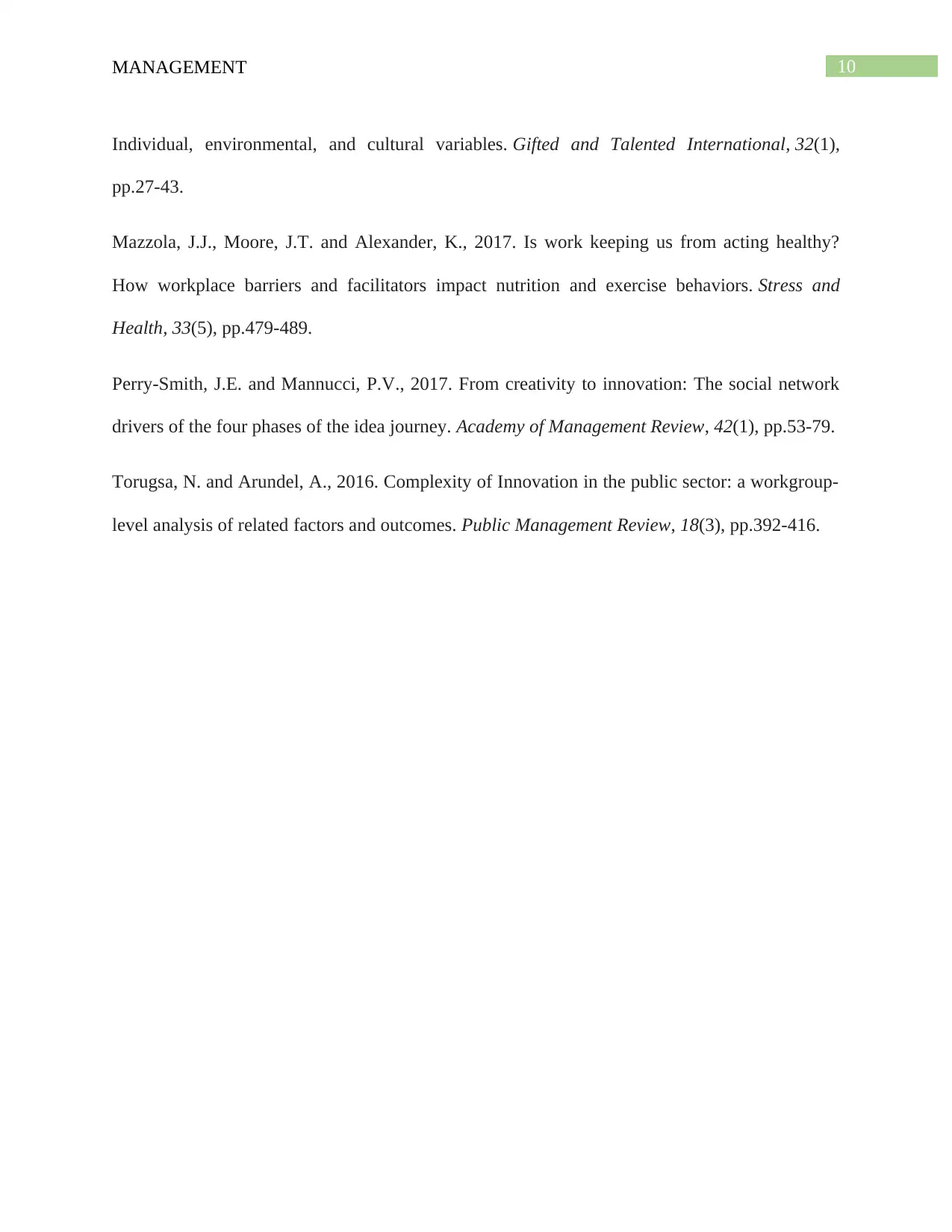
10MANAGEMENT
Individual, environmental, and cultural variables. Gifted and Talented International, 32(1),
pp.27-43.
Mazzola, J.J., Moore, J.T. and Alexander, K., 2017. Is work keeping us from acting healthy?
How workplace barriers and facilitators impact nutrition and exercise behaviors. Stress and
Health, 33(5), pp.479-489.
Perry-Smith, J.E. and Mannucci, P.V., 2017. From creativity to innovation: The social network
drivers of the four phases of the idea journey. Academy of Management Review, 42(1), pp.53-79.
Torugsa, N. and Arundel, A., 2016. Complexity of Innovation in the public sector: a workgroup-
level analysis of related factors and outcomes. Public Management Review, 18(3), pp.392-416.
Individual, environmental, and cultural variables. Gifted and Talented International, 32(1),
pp.27-43.
Mazzola, J.J., Moore, J.T. and Alexander, K., 2017. Is work keeping us from acting healthy?
How workplace barriers and facilitators impact nutrition and exercise behaviors. Stress and
Health, 33(5), pp.479-489.
Perry-Smith, J.E. and Mannucci, P.V., 2017. From creativity to innovation: The social network
drivers of the four phases of the idea journey. Academy of Management Review, 42(1), pp.53-79.
Torugsa, N. and Arundel, A., 2016. Complexity of Innovation in the public sector: a workgroup-
level analysis of related factors and outcomes. Public Management Review, 18(3), pp.392-416.
1 out of 11
Related Documents
Your All-in-One AI-Powered Toolkit for Academic Success.
+13062052269
info@desklib.com
Available 24*7 on WhatsApp / Email
![[object Object]](/_next/static/media/star-bottom.7253800d.svg)
Unlock your academic potential
Copyright © 2020–2025 A2Z Services. All Rights Reserved. Developed and managed by ZUCOL.




